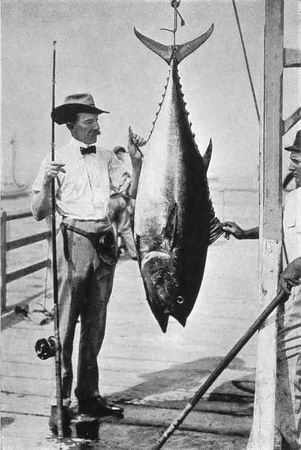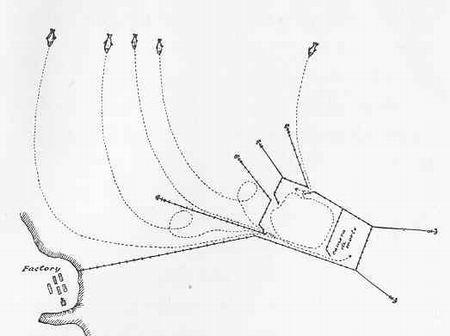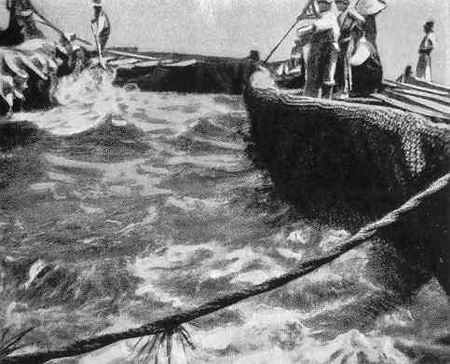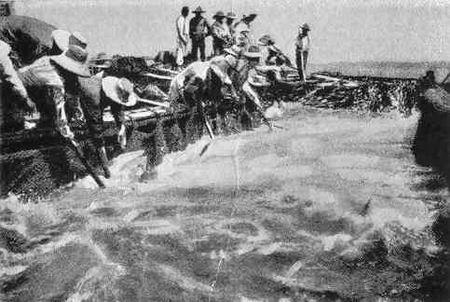|
1999-2003 (Return to Web Text-ures) |
Click Here to return to |
|
1999-2003 (Return to Web Text-ures) |
Click Here to return to |
III
TUNA FISHING
THERE has been so much written about tuna fishing at Catalina Island, Calif., that I do not purpose to describe again how it is done. Many of the accounts I have read are very picturesque, but for the most part so exaggerated that many people are frightened from trying to kill a tuna, and those who do try are so unnerved that they either fail or take hours instead of minutes to accomplish the task. A task it is, for the tuna is the strongest fish that one can fight with a rod.
My first visit to Catalina, some twenty years since, was crowned with success, as the fish were very plentiful. My second visit was in 1910, and the fish were very scarce. I landed one fish, the only one taken during my ten days’ visit. There were ten hooked fish reported, but they were lost, one of them after seventeen hours of struggle.
They tell me that there is a difference in tuna; that some are much stronger than others, which I do not doubt. My only experience has been with fourteen landed at Catalina and one lost at St. Ann’s Bay, Cape Breton Island. The latter I lost after thirty minutes, and was greatly relieved; for he looked to be over eight hundred pounds in weight, and was too strong for me and my tackle. From my experience at Catalina, I believe that any tuna up to two hundred pounds in weight should be landed in thirty minutes; but the tackle must be strong and sound, so that it causes you no thought, and you must have “hands.” The fascination of heavy fishing is the give and take between man and fish, the knowledge of what your tackle will stand, and the power that it gives you to convince the fish of the fact that you are his master. This is done by “hands,” just as riding a horse properly depends upon “hands.” No man can ride well who has not “hands,” and so it is with strong fishing. Brakes on reels do not help you, or they help you too much. They make you too strong, and your tackle suffers. Fish are no longer killed; they are murdered. It requires but little skill to fish with a reel brake, and it is the cause of the loss of most of the tuna hooked at Catalina.
My advice to a novice who wishes to land a tuna is: fish with a stiff rod and a sound line, keep your rod up, your left thumb on the reel, and do not let up on the fish. Do not use the brake when trolling. When the fish strikes, put all the strain on your tackle that it will stand, and stop your fish with thumb-pressure and the bend of the rod only. The farther the fish runs, the more quickly you will kill him, as it is very exhausting to a fish to travel fast under such a strain. If the drag is on, he will stop sooner; but being still fresh, he will try other methods which are more exhausting to you than to him. At the end of his first run is the moment to fight him to a finish. If he gets his second wind, he will be stronger than you. In this manner I killed a tuna on my last trip weighing 156˝ pounds in twelve minutes.

TUNA, 156 ˝ POUNDS
Time, 12 minutes
It is not easy to compare the two kinds of fishing, or to say which fish is more game, the tarpon or the tuna, for they act very differently. It is safe to say that they are imbued with quite different ideas when first hooked. The tarpon has no fear of boat or fisherman; his only idea is to shake the hook loose, and to do this he jumps out of the water, and will do so several times if you fight him hard. The harder you fight him, the more he jumps and the quicker he comes to gaff. I have never had a tarpon take more than 250 feet of line, and that in a tideway. I have heard of fish that have taken more, but am only telling of my own experience. The tuna, on the contrary, is off in a wild rush the moment he feels the hook, and I have had 650 feet of line taken from me before I could stop my fish. He then dwells, perhaps sounds, then runs again, perhaps twice, then sounds as a rule. From that time on it is a question of “pumping” your fish up to the boat, if you wish to kill the fish and not to allow him to commit suicide by towing you about. With proper tackle, either fish should be killed and gaffed within thirty minutes, barring accidents. If you are fortunate enough to hook your tuna in the upper jaw and hold him hard during his first run, he comes to the surface virtually drowned, and if you are quick, it takes only a few minutes to bring him to gaff.
The method of fishing for tuna is to troll from a power-launch or from a rowboat astern of such a launch, with a flying-fish for bait. The tuna follows the bait, strikes at the head, and turns as he strikes, so that he is generally hooked in the corner of the mouth, and makes his run with his mouth closed. To kill him in such cases you must tire him out. The water is very deep off Catalina—hundreds of feet deep. When your fish sounds, if you wait a few moments, he will discover that the pressure of the water is more comfortable nearer the surface. The great depth of water is an advantage as well as a discomfort to the fish.
I proved to my own satisfaction years since that every tarpon should be brought to gaff within thirty minutes, and went to Catalina Island to see if the same could be done with the tuna, with the following result:
June 5: tuna, 150 pounds, 2 hours,
20 minutes.
June 6: tuna,
130 pounds, 1 hour, 17 minutes.
June 8: tuna,
102 pounds, 19 minutes.
June 9: tuna,
123 pounds, 19 minutes; tuna, 104 pounds, 45 minutes.
June 10:
tuna, 118 pounds, 27 minutes; tuna, 88 pounds, 20 minutes; tuna, 100 pounds, 17
minutes.
June 11:
tuna, 99 pounds, 15 minutes; tuna, 103 pounds, 14 minutes; tuna, 62 pounds, 8
minutes; tuna, 109 pounds, 9 minutes; tuna, 118 pounds, 20 minutes.
Total: thirteen fish, 1411 pounds.
I fought my first fish with a rod that had a flaw in it, and the reel was spread by the second fish, yet I averaged about thirty minutes on the thirteen, and five of them I killed in one day in six hours’ fishing. I used a stout rod, a Vom Hofe Star reel, holding eight hundred feet of No. 22 Hall line, and Van Vleck tarpon trolling-hook with swivel and piano-wire snood.
The leaping tuna do not jump after being hooked, but do when chasing schools of flying-fish, hence the epithet.
Now, to answer the question, which is the more game, the fish that stands and fights, the tarpon; or the tuna, the fish that runs away, then holds on and fights to the last moment? I say the tarpon. Yet there is no sea-fishing sensation equal to the first grand run of a hooked tuna, and he is a harder fish to kill than the tarpon.
I took my fishing-tackle with me to Sicily one April, looking for sport with tuna (the famous tunny-fish of the ancients), but found I was too early, as the fish do not appear in those waters until the early summer.
Permanent tuna fisheries and fish factories exist at Syracuse and Palermo and at other places along the coast. In setting the nets, advantage is taken of a strange fact. The fish are known to travel in certain directions along the coast, and when they meet with an obstruction, they always turn to the left. I was told that the fishermen in Italy, therefore, believe that the fish see only out of the right eye. A strong, deep net is anchored offshore and secured to kedges. It is a trap-net, open toward the sea, and the inner chamber has a strong floor. At Palermo there is a stone tower on shore from which a watchman watches the nets and announces with a bell the arrival of a school of tuna. When the fish are intercepted by the nets, they keep turning to the left, until they arrive in the camera di morte, or death-chamber. The watchman having announced the arrival of the fish, and the fishermen, armed with strong gaffs, having appeared in boats, the inner gate is closed. After hauling in the slack of the stout net, the slaughter begins. I was told the fishing at Palermo some years would net $10,000, notwithstanding that the installation of the nets cost a like amount, and the yearly rental of twenty miles of shore water was $4,000. The fish run up to 500 pounds in weight, but the majority are much smaller. It is said that a 100-pound tuna is worth 100 francs ($20) at the factory, which seems excessive, though every part of the fish has a commercial value. The meat is salted and canned, and is a staple article of food. The trade is protected, no tunny products being allowed to pass the customs into Italy.

A TUNA NET, SICILY

TUNA NETS, SICILY
Along the southern and western coasts of Spain and the western coast of France the tuna are caught by fleets of small seaworthy vessels with strong lines rigged on outrigger poles. Bait is used, with large, strong hooks.
It is a strange fact that although these fish are found in great numbers in the warm waters of the Mediterranean, they are seldom seen along our Atlantic coast south of Cape Cod. They have been reported off the coast of New Jersey and in the waters between Block Island and Montauk Point. The horse-mackerel is still found between Cape Cod and Labrador, and at one time is said to have been often met with. The schools of herring, mackerel, and menhaden have either disappeared, or remain farther offshore than in former years, and the horse-mackerel, being a good feeder, must follow the smaller fish.
I had read that the tuna were very plentiful along the western coast of Newfoundland. I cruised from Port-aux-Basques to the beautiful Humber Sound, Bay of Islands, and back, in the summer of 1911, without seeing a single fish, nor could I obtain any information concerning them. I have found the tuna on two visits to St. Ann’s Bay, Cape Breton Island, but found it very difficult to get to them; for they seem to come into the bay on the tide, turn, and go out to sea again, and rarely dwell. St. Ann’s Bay is open to the northeast, and it is seldom that the sea is in such condition that it is safe to fish. Then, again, it is almost impossible to obtain bait. The waters seem bare of fish of any kind, which must account for the short visits of the tuna, for they will not remain where there is no food.

HAULING THE NETS, SICILY

GAFFING THE FISH, SICILY
Camera di morte
Mr. J. K. L. Ross, who passes his summers at St. Ann’s Bay, is the pioneer of the tuna fishing there. He has had great sport during the last four seasons, having been fast to more than fifty of these giant fish during that time. He was unsuccessful until the twenty-eighth of August, 1911, when he succeeded in landing, after a fight lasting four hours and forty-five minutes, a fish eight feet ten inches long, with a girth of six feet three inches, and weighing 680 pounds on the scales at Sydney twenty-four hours later. It was a wonderful and well-deserved victory after all his trouble and his never-ending hospitality and kindness to visiting fishermen.
The fish in those waters are of great size. I saw one near at hand which, I think, must have weighed at least 1,500 pounds.
Click
here to continue to the next chapter of
Some Fish and Some Fishing